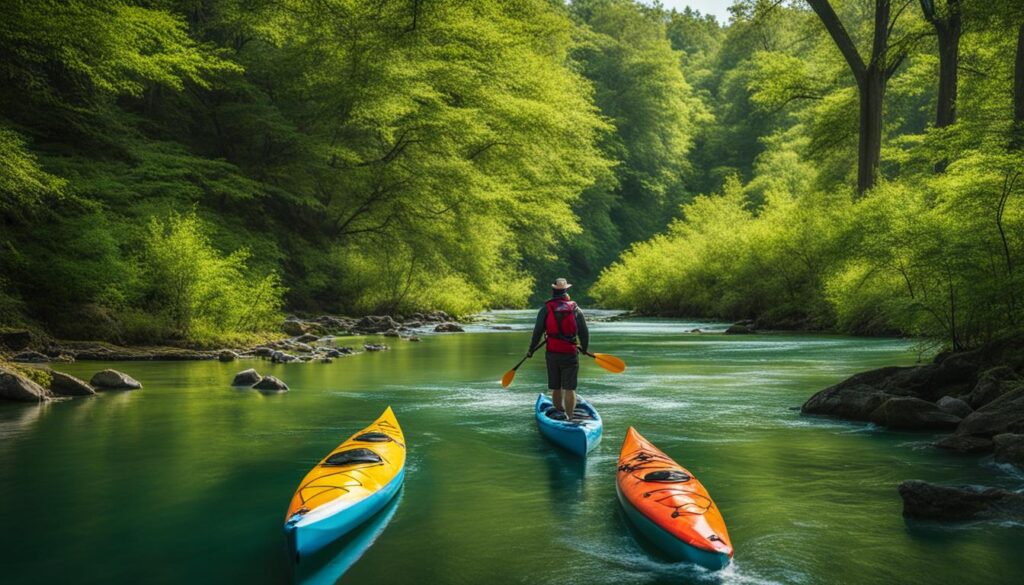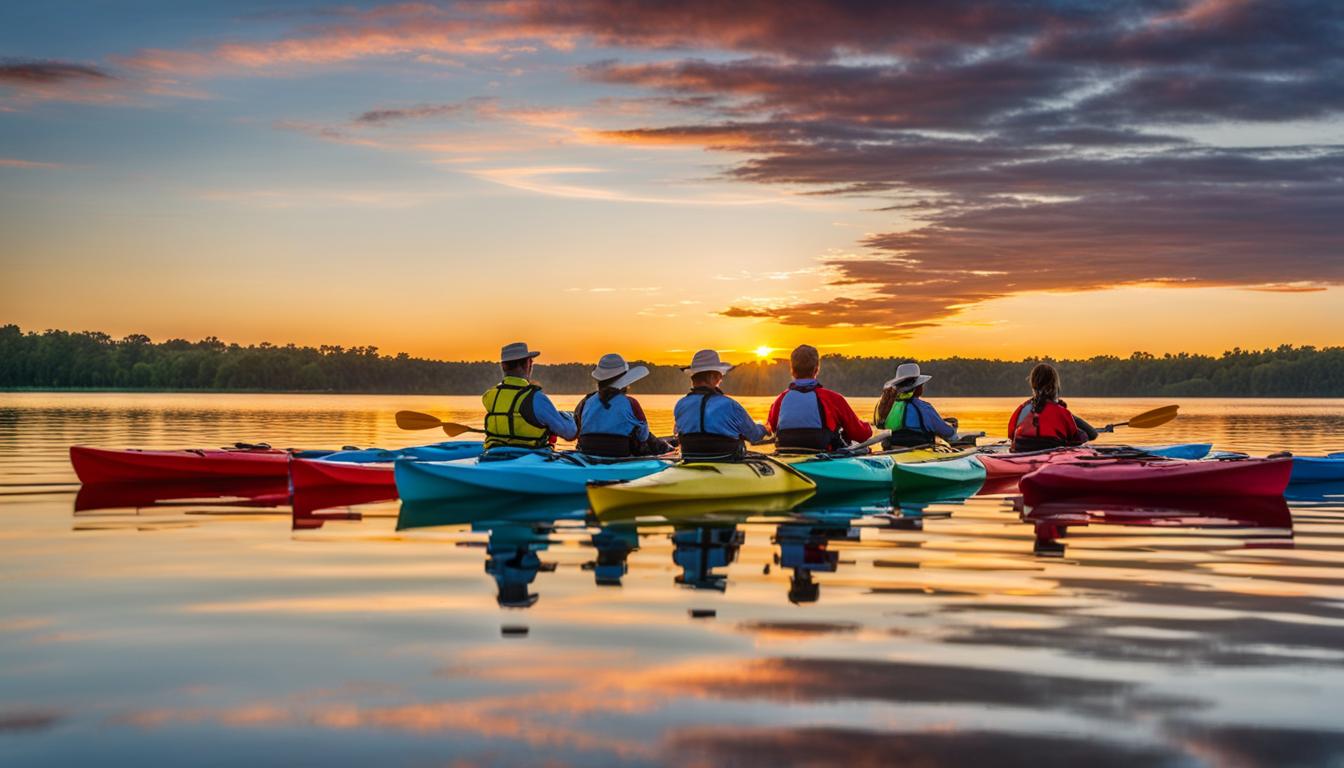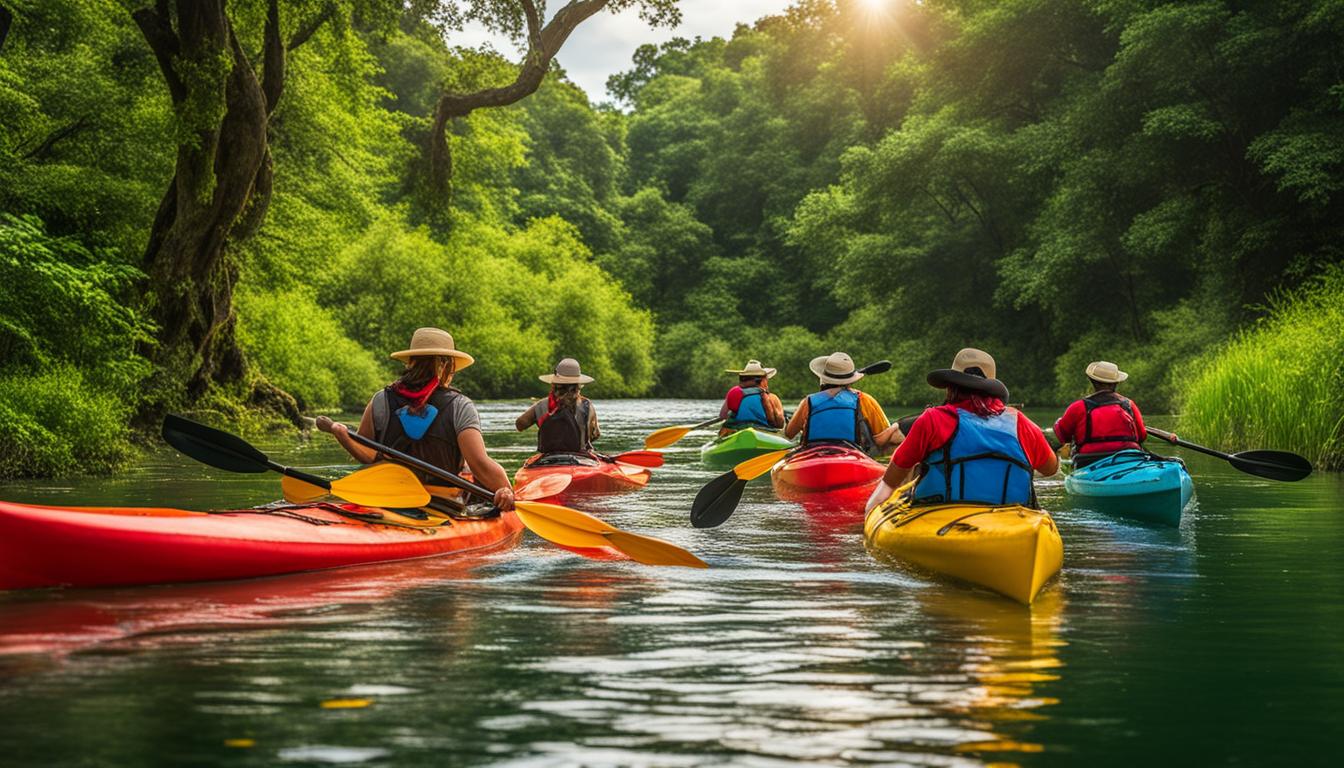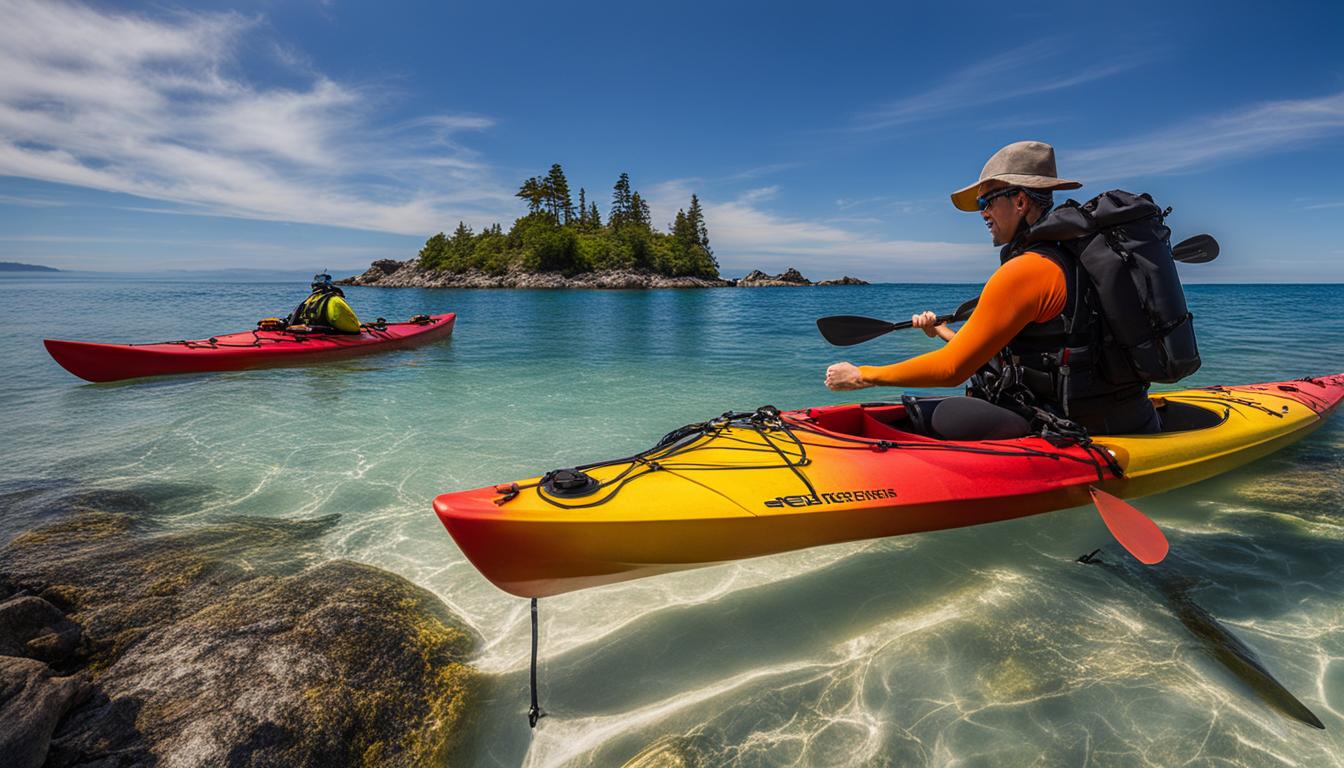When planning your next kayaking adventure, you may find yourself faced with a decision: should you opt for a guided tour or go it alone with a self-guided trip? Both options have their advantages and offer unique experiences, so it’s important to consider what suits your adventure style best.
Comparing guided and self-guided kayak trips can help you determine which option aligns with your preferences. Guided trips typically come with the expertise of professional guides who can offer valuable knowledge about the area, point out interesting sights, and ensure your safety. On the other hand, self-guided trips provide the freedom to explore at your own pace and customize your itinerary.
Let’s take a closer look at the pros and cons of each option, as well as factors to consider when making your decision.
Key Takeaways:
- When choosing between guided and self-guided kayak trips, consider your desired level of independence and the type of experience you want.
- Guided trips offer the convenience of expert guides, safety precautions, and structured itineraries.
- Self-guided trips provide the freedom to explore at your own pace and customize your adventure.
- Factors such as your level of experience, knowledge of the area, and comfort level should be taken into account.
- Both guided and self-guided kayak trips can be rewarding and offer the thrill of kayaking in beautiful waterways.
Pros and Cons of Guided Kayak Trips
Guided kayak trips offer several advantages that can enhance your kayaking experience. Here are a few reasons why you might consider choosing a guided tour:
- Expert knowledge: Professional guides are well-versed in the area and can provide valuable insights about the local geography, wildlife, and cultural history. They can enrich your trip by sharing interesting facts and stories along the way.
- Safety: Guided tours prioritize your safety. Guides are trained in water safety and rescue procedures, ensuring that you can enjoy your adventure with peace of mind. They can also provide instruction on proper paddling techniques and equip you with the necessary safety gear.
- Points of interest: Experienced guides know the best spots to explore and can lead you to hidden gems you might otherwise miss. They can point out unique features of the environment, such as secluded caves, stunning vistas, and rare wildlife sightings.
- Challenging waters: If you’re a beginner or unfamiliar with navigating challenging waters, a guided tour can provide the necessary support. Guides can help you navigate through rapids, tides, or other potentially tricky conditions, ensuring a safe and enjoyable experience.
However, guided kayak trips also have some potential drawbacks to consider:
- Limited flexibility: Guided tours often follow a predetermined itinerary, which means you have less control over the pace and duration of your trip. This structured nature may not suit those who prefer to have the freedom to explore at their own leisure or make spontaneous detours.
- Group dynamics: Guided trips usually involve traveling in a group with other participants. While this can be a great opportunity to meet fellow adventurers, it may also mean compromising on personal preferences and adjusting to the dynamics of the group.
- Cost: Guided kayak trips typically come at a higher cost compared to self-guided options. This is due to the services provided by the guides, including their expertise, equipment, and transportation logistics. If you’re on a tight budget, a guided tour may not be the most economical choice.
“I had an amazing experience on a guided kayak trip in [destination]. Our guide was incredibly knowledgeable and showed us breathtaking sights that we wouldn’t have discovered on our own. It was reassuring to have their expertise and support, especially when navigating through choppy waters. The only downside was that we had limited time at each location, and I wished we could have spent more time exploring on our own. Overall, I highly recommend guided kayak trips for those seeking a well-organized and educational adventure.” – [Anonymous]
Table: Comparing Guided and Self-Guided Kayak Trips
| Factors | Guided Trips | Self-Guided Trips |
|---|---|---|
| Knowledge and insights | Provided by professional guides | Self-researched or limited |
| Safety | Guides prioritize safety and provide assistance | Requires self-navigation and knowledge of safety protocols |
| Flexibility | Follows a predetermined itinerary | Freedom to customize the itinerary |
| Group dynamics | Opportunity to meet and socialize with other participants | Independence and solitude |
| Cost | Higher due to guide services and equipment | Lower, only includes equipment rental |
Keep in mind that the choice between guided and self-guided kayak trips ultimately depends on your preferences, experience level, and desired level of independence. Consider the factors that are most important to you, such as the need for expert guidance, flexibility in itinerary, and budget constraints. Both options offer their unique advantages and can provide an enjoyable kayaking experience.
Pros and Cons of Self-Guided Kayak Trips
Self-guided kayak trips offer a range of benefits that appeal to adventure seekers who value freedom and customization. It’s important to consider both the advantages and disadvantages to determine if this type of trip is right for you.
Benefits of Self-Guided Kayak Trips
One of the main advantages of self-guided kayak trips is the freedom to explore at your own pace. You have the flexibility to choose your itinerary, allowing for spontaneous detours and extended stops at points of interest. This level of independence can be particularly appealing for those who enjoy solitude and want to connect with nature on their own terms.
Additionally, self-guided trips provide an opportunity for personal growth and skill development. You’ll need to plan your route, navigate the waters, and make decisions about safety precautions. This hands-on experience can enhance your kayaking abilities and build confidence in your outdoor skills.
Considerations for Self-Guided Kayak Trips
While self-guided kayak trips offer freedom and personal growth, they do come with some challenges. Planning and preparation are essential to ensure a smooth journey. You’ll need to research the area, study maps, and understand potential hazards. It’s also important to have navigation skills and knowledge of kayaking techniques to navigate the waters safely.
In addition, self-guided trips may lack the guidance and expertise of a professional guide. Without a guide, you won’t have access to their knowledge of the area, wildlife sightings, or local insights. In case of emergencies, you’ll need to rely on your own resources and problem-solving abilities.
Overall, self-guided kayak trips offer the freedom to create your own adventure and connect with nature on a deeper level. However, they require careful planning, navigation skills, and a sense of self-reliance. Consider your comfort level, experience, and desired level of independence when deciding if a self-guided trip is right for you.

Factors to Consider When Choosing Between Guided and Self-Guided Kayak Trips
When deciding between guided and self-guided kayak trips, there are several important factors to consider. Your level of experience, knowledge of the area, desired level of independence, and the type of experience you’re seeking all play a role in determining which option is best for you.
If you’re a novice kayaker or unfamiliar with the area, a guided kayak trip can provide the support and expertise you need. Professional guides offer valuable knowledge about the region, including points of interest, wildlife sightings, and local history. They can also ensure your safety and provide assistance in challenging waters. Guided trips often follow a pre-planned itinerary, which can be beneficial for those who prefer a structured experience.
On the other hand, if you’re an experienced kayaker looking for more freedom and flexibility, a self-guided trip might be the better choice. Self-guided kayak trips allow you to explore at your own pace and customize your itinerary to suit your interests. This level of independence can be particularly appealing for those who enjoy solitude and want to fully immerse themselves in nature. However, it’s important to note that self-guided trips require more planning and navigation skills. Without a guide, you’ll need to be prepared to handle any challenges that may arise and be responsible for your own safety.
Planning a Self-Guided Kayak Journey
When planning a self-guided kayak journey, it’s essential to have a thorough understanding of the area you’ll be exploring. Research the waterways, study maps, and familiarize yourself with any regulations or permits that may be required. It’s also important to assess your own skill level and ensure you have the necessary equipment and supplies for the trip, including a reliable kayak, proper safety gear, and navigation tools such as a compass or GPS device.
Take the time to create a detailed itinerary, outlining your daily routes, potential campsites, and points of interest along the way. Consider factors such as weather conditions, water levels, and any potential hazards or obstacles you may encounter. While self-guided trips offer flexibility, it’s still important to have a plan in place to ensure your safety and make the most of your journey.
In conclusion, the choice between guided and self-guided kayak trips ultimately comes down to your preferences and the type of experience you desire. A guided trip provides the convenience of expert guidance and a structured itinerary, while a self-guided trip offers the freedom to explore at your own pace. Consider your level of experience, desired level of independence, and available resources when making your decision. Both options can be rewarding and allow you to enjoy the beauty of kayaking in stunning waterways.

Table: Comparison of Guided and Self-Guided Kayak Trips
| Guided Kayak Trips | Self-Guided Kayak Trips | |
|---|---|---|
| Experience Level | Suitable for novice to experienced kayakers | Recommended for experienced kayakers |
| Knowledge and Guidance | Professional guides provide expert knowledge and assistance | Requires personal research and navigation skills |
| Flexibility | Follows a structured itinerary | Allows for customization of itinerary |
| Independence | Less freedom and independence | Greater freedom and independence |
| Safety | Guides ensure safety and navigate challenging waters | Responsibility for personal safety |
Conclusion
When it comes to choosing between guided and self-guided kayak trips, it ultimately boils down to your personal preferences and the type of experience you’re seeking. Guided tours offer the convenience of having a knowledgeable guide who can provide valuable insights and ensure your safety. They also come with a structured itinerary, taking away the planning burden.
On the other hand, self-guided kayak trips offer a great deal of freedom and flexibility. You have the opportunity to customize your own adventure, exploring at your own pace and connecting with nature on your terms. However, it is important to note that self-guided trips require more planning and navigation skills on your part.
When making your decision, consider your comfort level, desired level of independence, and available resources. If you prefer a more structured experience and feel more at ease with a guide, a guided kayak trip might be the way to go. If you enjoy the thrill of customization and have the necessary skills and knowledge, a self-guided kayak adventure can be incredibly rewarding.
Remember to take into account the essentials for self-guided kayak adventures, such as having the appropriate equipment and navigation tools. Customizing a self-guided tour allows you to tailor the experience to your liking, ensuring a memorable and enjoyable journey through the beautiful waterways.
FAQ
What are the advantages of guided kayak trips?
Guided kayak trips offer expert knowledge, safety assurance, and assistance in navigating challenging waters.
What are the benefits of self-guided kayak trips?
Self-guided kayak trips provide freedom, flexibility, and the opportunity to explore at your own pace.
Are guided tours suitable for novice kayakers?
Yes, guided tours are a great option for novice kayakers as they provide professional guidance and a structured itinerary.
Do self-guided trips require advanced navigation skills?
Yes, self-guided trips require more planning and navigation skills as you will be responsible for charting your own course.
Can I customize my itinerary on a guided kayak trip?
While guided kayak trips have a structured itinerary, some operators may offer customization options based on group preferences.
Will there be a guide to provide information on a self-guided kayak trip?
No, self-guided kayak trips do not typically include a guide, so you will need to rely on your own knowledge and research.
Which type of trip is better for experienced kayakers?
Experienced kayakers who prefer independence and exploring at their own pace may find self-guided trips more suitable.
What factors should I consider when choosing between guided and self-guided kayak trips?
Factors to consider include your level of experience, knowledge of the area, desired level of independence, and the type of experience you’re seeking.
Are both guided and self-guided kayak trips rewarding?
Yes, both guided and self-guided kayak trips can be rewarding, offering the thrill of kayaking in beautiful waterways.





